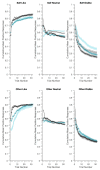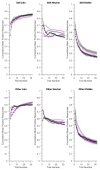A Reduced Self-Positive Belief Underpins Greater Sensitivity to Negative Evaluation in Socially Anxious Individuals
- PMID: 34212077
- PMCID: PMC7611100
- DOI: 10.5334/cpsy.57
A Reduced Self-Positive Belief Underpins Greater Sensitivity to Negative Evaluation in Socially Anxious Individuals
Abstract
Positive self-beliefs are important for well-being, and are influenced by how others evaluate us during social interactions. Mechanistic accounts of self-beliefs have mostly relied on associative learning models. These account for choice behaviour but not for the explicit beliefs that trouble socially anxious patients. Neither do they speak to self-schemas, which underpin vulnerability according to psychological research. Here, we compared belief-based and associative computational models of social-evaluation, in individuals that varied in fear of negative evaluation (FNE), a core symptom of social anxiety. We used a novel analytic approach, 'clinically informed model-fitting', to determine the influence of FNE symptom scores on model parameters. We found that high-FNE participants learn more easily from negative feedback about themselves, manifesting in greater self-negative learning rates. Crucially, we provide evidence that this bias is underpinned by an overall reduced belief about self-positive attributes. The study population could be characterized equally well by belief-based or associative models, however large individual differences in model likelihood indicated that some individuals relied more on an associative (model-free), while others more on a belief-guided strategy. Our findings have therapeutic importance, as positive belief activation may be used to specifically modulate learning.
Author summary: Understanding how we form and maintain positive self-beliefs is crucial to understanding how things go awry in disorders such as social anxiety. The loss of positive self-belief in social anxiety, especially in inter-personal contexts, is thought to be related to how we integrate evaluative information that we receive from others. We frame this social information integration as a learning problem and ask how people learn whether someone approves of them or not. We thus elucidate why the decrease in positive evaluations manifests only for the self, but not for an unknown other, given the same information. We investigated the mechanics of this learning using a novel computational modelling approach, comparing models that treat the learning process as series of stimulusresponse associations with models that treat learning as updating of beliefs about the self (or another). We show that both models characterise the process well and that individuals higher in symptoms of social anxiety learn more from negative information specifically about the self. Crucially, we provide evidence that this originates from a reduction in the amount of positive attributes that are activated when the individual is placed in a social evaluative context.
Keywords: associative learning; belief update; computational psychiatry; social anxiety.
Conflict of interest statement
COMPETING INTERESTS The authors have no competing interests to declare.
Figures




Similar articles
-
Negative and positive self-beliefs in social anxiety: The strength of believing mediates the affective response.PLoS One. 2023 Mar 15;18(3):e0281387. doi: 10.1371/journal.pone.0281387. eCollection 2023. PLoS One. 2023. PMID: 36920983 Free PMC article.
-
Lack of optimistic bias during social evaluation learning reflects reduced positive self-beliefs in depression and social anxiety, but via distinct mechanisms.Sci Rep. 2024 Sep 28;14(1):22471. doi: 10.1038/s41598-024-72749-6. Sci Rep. 2024. PMID: 39341892 Free PMC article.
-
Fear of negative evaluation biases social evaluation inference: evidence from a probabilistic learning task.PLoS One. 2015 Apr 8;10(4):e0119456. doi: 10.1371/journal.pone.0119456. eCollection 2015. PLoS One. 2015. PMID: 25853835 Free PMC article.
-
Folic acid supplementation and malaria susceptibility and severity among people taking antifolate antimalarial drugs in endemic areas.Cochrane Database Syst Rev. 2022 Feb 1;2(2022):CD014217. doi: 10.1002/14651858.CD014217. Cochrane Database Syst Rev. 2022. PMID: 36321557 Free PMC article.
-
[Role of the implicit theories of intelligence in learning situations].Encephale. 2004 Sep-Oct;30(5):456-63. doi: 10.1016/s0013-7006(04)95460-7. Encephale. 2004. PMID: 15627050 Review. French.
Cited by
-
Impressions about harm are formed rapidly and then refined, modulated by serotonin.Soc Cogn Affect Neurosci. 2024 Oct 23;19(1):nsae078. doi: 10.1093/scan/nsae078. Soc Cogn Affect Neurosci. 2024. PMID: 39460542 Free PMC article. Clinical Trial.
-
Neurocognitive Model of Schema-Congruent and -Incongruent Learning in Clinical Disorders: Application to Social Anxiety and Beyond.Perspect Psychol Sci. 2023 Nov;18(6):1412-1435. doi: 10.1177/17456916221141351. Epub 2023 Feb 16. Perspect Psychol Sci. 2023. PMID: 36795637 Free PMC article.
-
Different components of cognitive-behavioral therapy affect specific cognitive mechanisms.Sci Adv. 2024 Mar 29;10(13):eadk3222. doi: 10.1126/sciadv.adk3222. Epub 2024 Mar 27. Sci Adv. 2024. PMID: 38536924 Free PMC article.
-
Neural processes related to negative self-concept in adult and adolescent anorexia nervosa.Eur Eat Disord Rev. 2022 Jan;30(1):23-35. doi: 10.1002/erv.2867. Epub 2021 Oct 15. Eur Eat Disord Rev. 2022. PMID: 34655143 Free PMC article.
-
Blend in or stand out: social anxiety levels shape information-sharing strategies.Proc Biol Sci. 2022 May 25;289(1975):20220476. doi: 10.1098/rspb.2022.0476. Epub 2022 May 25. Proc Biol Sci. 2022. PMID: 35611531 Free PMC article.
References
-
- Brown, V. M., Chen, J., Gillan, C. M., & Price, R. B. (2020). Improving the Reliability of Computational Analyses: Model-Based Planning and Its Relationship With Compulsivity. Biological Psychiatry: Cognitive Neuroscience and Neuroimaging, 5(6), 601–609. Retrieved 2020-08-31, from http://www.sciencedirect.com/science/article/pii/S2451902220300161. DOI: 10.1016/j.bpsc.2019.12.019 - DOI - PMC - PubMed
-
- Browning, M., Behrens, T. E., Jocham, G., O’Reilly, J. X., & Bishop, S. J. (2015). Anxious individuals have difficulty learning the causal statistics of aversive environments. Nature neuroscience, 18(4), 590–596. Retrieved from http://www.ncbi.nlm.nih.gov/pmc/articles/PMC4644067/. DOI: 10.1038/nn.3961 - DOI - PMC - PubMed
Grants and funding
LinkOut - more resources
Full Text Sources

